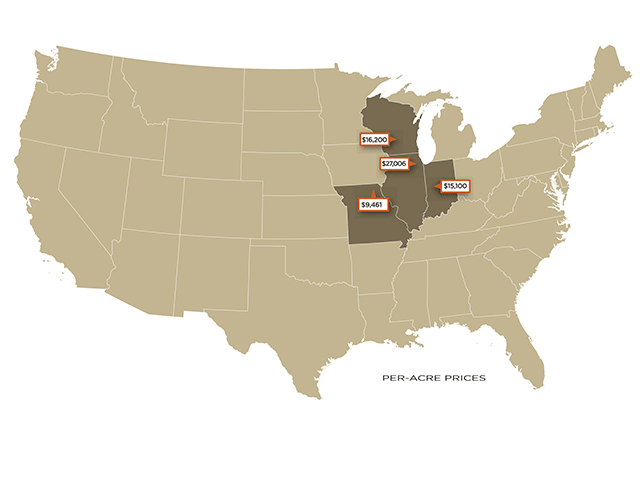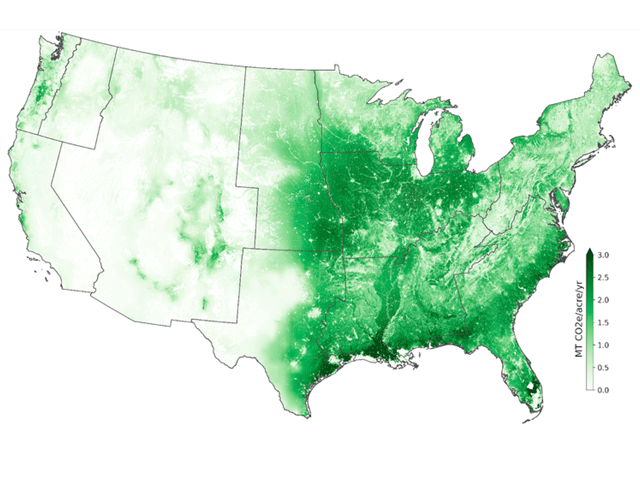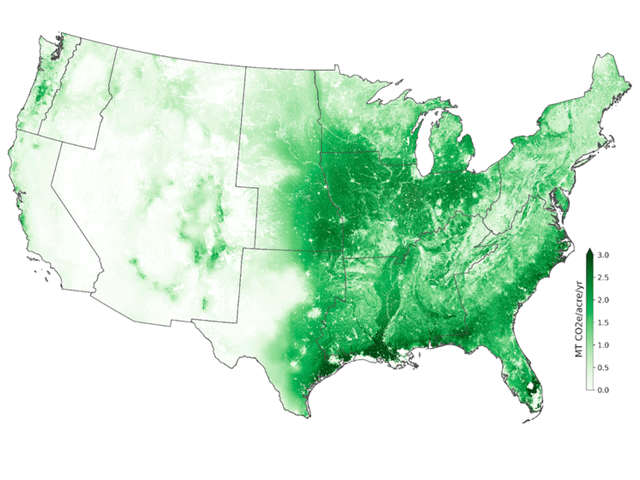Ag Policy Blog
Report: Climate-Smart Policies Could Cut Farm and Forest Emissions
Mobilizing and expanding climate-smart policies like those in the 2018 farm bill, the Inflation Reduction Act (IRA), and state reforestation programs could allow the United States to cut net emissions from forests and farmland by 72% by 2035 from 2021 levels and keep the U.S. on track toward its 2050 net-zero commitments, according to a report to be released Wednesday.
The report, "Harnessing the Land Sector to Achieve U.S. Climate Goals," was released by Michael Bloomberg, the former New York mayor who is now a UN special envoy on climate, and Gina McCarthy, an Environmental Protection Agency administrator in the Obama administration and White House climate adviser in the Biden administration. The two co-chair a group called America Is All In.
The work behind the report was conducted by the Center for Global Sustainability (CGS) at the University of Maryland.
The report appears to bolster the case for keeping nearly $20 billion in conservation policies from the Inflation Reduction Act (IRA) in conservation rather than shifting those dollars to other farm bill priorities such as the reference prices that trigger farm subsidy payments, as Republicans have proposed.
Carbon sequestration in the U.S. based on land use reduced overall emissions nationally by 12% in 2021, reflecting the potential as a carbon sink to meet emission goals in 2030 and 2050.
One "paramount" driver to continuing the sector's emission reductions and sequestration potential is building on the IRA with "the addition and implementation of enhanced climate-smart, comprehensive federal legislation -- such as a renewed farm bill."
The report says federal actions, all funded by the IRA, that are needed to achieve the all-in reduction potential in the agricultural sector include:
P[L1] D[0x0] M[300x250] OOP[F] ADUNIT[] T[]
- Renewing and expanding the USDA Environmental Quality Incentives Program.
- Expanding federal funding for the USDA Conservation Stewardship Program to aid farmers in adopting energy-efficient technologies and promoting carbon sequestration in otherwise unproductive rangelands.
- Increasing federal funding for the USDA Agricultural Conservation Easement Program.
Still, to achieve a 72% reduction in agricultural and forestry emissions by 2035 would require "enhanced ambition" in different sectors. For agriculture, that would require "an expansion of livestock manure management activities in dairy, beef, and pork production systems," as well as reducing emissions by changes in feed mix as well. Other areas to lower emissions would include "slight reductions in fertilizer usage," and a switch to alterative wet and dry rice production to lower methane emissions."
To further drive down livestock emissions, the report highlights financial incentives and subsidies to help with manure management. Yet, the report also states that a "federal methane fee" of $1,500 per ton of methane "could incentivize livestock and rice producers to implement economically feasible emission reduction actions. Even a lower fee of $250 per ton would also drive down emissions in agriculture.
"Smart land use policies are highly effective at reducing carbon emissions and fostering climate resilience," Bloomberg, UN Secretary-General's Special Envoy on Climate Ambition and Solutions and founder of Bloomberg LP and Bloomberg Philanthropies, said in a news release. "This report shows that by investing in our nation's forests and farmland, we can accelerate America's progress in reaching our climate targets, while also improving public health, creating good jobs, and saving lives. It's an idea that both parties should rally around."
"Our nation's farms and forests are absolutely crucial to helping the U.S. meet our climate goals," said McCarthy, managing co-chair of America Is All In. "Through creative policies and unprecedented investments in conservation, ecosystem restoration, and climate-smart agriculture, we can give our farmers, foresters, and ranchers the tools they need to continue feeding the world by absorbing more carbon pollution that cleans the air and reduces the risks of more extreme weather."
"We need to use every possible tool in our toolbox to cut our emissions and meet our climate goals, and that includes prioritizing the expansion of our carbon sink in this decade," added Shannon Kennedy, senior manager of strategic engagement at CGS and the report's lead author. "Our report offers the first-ever look at how we can maximize and expand today's land use policies to accelerate emissions reductions from the agriculture and forestry sectors -- incorporating reforestation, conservation, wildfire mitigation, and sustainable farming practices -- not only safeguarding our natural carbon sink from emitting more than it absorbs but also fostering economic and societal progress."
According to the report, the U.S. can increase its carbon sink largely through growth and expansion of the country's forests and ecosystems, but it must be paired with new action to protect these vital eco-infrastructures and increase climate-smart agricultural investments, Kennedy added. Otherwise, climate-induced droughts and fires could significantly degrade this valuable sink by the 2030s and beyond, endangering climate stabilization goals.
The biggest opportunities to increase carbon sequestration are in Southern and Midwestern states, the report says.
- Report - Harnessing the Land Sector to Achieve U.S. Climate Goals https://www.americaisallin.com/…
DTN Ag Policy Editor Chris Clayton contributed to this report.
Jerry Hagstrom can be reached at jhagstrom@nationaljournal.com
Follow him on X, formerly known as Twitter, @hagstromreport
(c) Copyright 2024 DTN, LLC. All rights reserved.






Comments
To comment, please Log In or Join our Community .